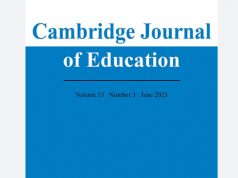The ways in which digital technologies are now produced, consumed and discarded is of growing environmental concern. As such, the escalating use of digital technologies in schools is set to become increasingly problematic if not ultimately unsustainable. Of course, the conundrum of what to do after the world passes the point of ‘Peak ICT’ is not unique to education. Nevertheless, the field of EdTech will soon be facing the stark fact that “the finite-ness of our planet sets hard non-negotiable limits”.
So, what can be done? Sadly, the most likely scenario is that we carry on regardless. Most people working in education are already well-aware of the environmental and ethical issues associated with digital technology use. Similarly, most people are now accustomed to doing very little in response. After all, what can one really do? These are huge planetary-scale dilemmas that stretch far beyond the purview of the average school teacher or systems administrator. Even when cognisant of the dangers, these issues are very difficult to confront meaningfully.
Yet regardless of how daunting it is, the education community needs to quickly curtail the environmental and ethical impacts of its digital technology consumption if there is to be a viable future for EdTech. Put bluntly, the priority for everyone working in the area of education and technology needs to be a rapid collective change of attitude and action.
Of course, there are a few good habits that we can all immediately adopt. For example, it remains sensible to turn devices on only when they are being used, to dim screen brightness, and adopt EPEAT standards when purchasing any new device. These are certainly steps in the right direction, yet such actions will only marginally impact on the major environmental consequences of digital technology use. Switching off unattended school devices is unlikely to do much to counter the likelihood that the ICT industry will be using 20 per cent of all the world’s electricity by 2025, and that planetary supplies of basic natural resources such as copper and lithium will continue to diminish at considerable rates.
It is important to recognise from the outset, then, that this is a challenge where there are no quick solutions or ‘easy wins’. Instead, we need to follow John Michael Greer’s (2008) distinction that environmental degradation is not a problem that can ever be solved, but a predicament that has to be lived with as best we can. Rather than waiting for a ‘technical fix’ to somehow magic these issues away, it now falls to everyone involved in education to adjust their technological mind-set. In crude terms, there is little to be done but ‘suck it up’ and reassess the ways that education is able to engage with technology.
So, how might we develop new approaches that move education on from its current unhealthy reliance on excessive technology use and over-consumption? One promising approach is the ‘Computing Within Limits’ movement that is growing within various areas of academic computer science. This attempts to identify and promote forms of computing that are best suited for a resource-constrained planet. As Pargman and Wallsten put it, the emphasis here is on planning future technology use with a primary aim of “coping with finiteness”. This involves abandoning the ‘cornucopian’ assumptions of limitlessness and abundance that have bloated digital technology use over the past 30 years. Instead, we need to develop radically leaner and ecologically-mindful approaches to rethinking how digital technologies might be best deployed.
Computing Within Limits therefore suggests a root-and-branch reform of most of the fundamental presumptions about digital technology that have taken hold in education over the past few decades. For example, in a resource-constrained future it will make little sense to expect every teacher and student to individually possess their own personal digital devices. Similarly, will it make no sense for hardware to be frequently upgraded. It will no longer be feasible to demand instantaneous and continuous access to the internet, unlimited perpetual data storage and high-bandwidth connections. It will no longer be appropriate to expect high-definition content to be stored in multiple versions and ‘shared’ repeatedly across many different platforms.
A couple of decades from now, these will all seem excessively wasteful and ignorant ways to be consuming technology. Indeed, in practical terms it will simply not be possible to continue to use technology in this manner. As such, it surely makes sense to now start planning in advance for a markedly different mode of technology use ‘within limits’. If our work is to have any longevity at all, then educational technology throughout the 2020s needs to be reoriented in preparation for the constrained environmental conditions of the decades thereafter. Some possible forms this might take include:
- Reframing EdTech as a communal endeavour. Schools could move away from expectations of ‘one-student-per-device’ to a culture of ‘many-people-per-device’. This might require device-sharing amongst individuals (in a similar vein to car sharing), or ‘shared resource libraries’ where neighbourhood institutions can borrow otherwise sporadically-used devices such as 3D printers, drones and VR headsets.
- Ethical procurement. Instead of purchasing brand-new technology, schools should look to acquire refurbished, hand-me-down and gifted hardware. In contrast to current expectations for school children to own iPads and MacBooks, there are very few reasons to be using high-spec business-standard technology. As well as looking to procure pre-used hardware, school administrators should evaluate and make public the ecological impact and sustainability of any new technology acquisition.
- Maintainable (rather than disposable) digital hardware. Rather than upgrading hardware every few years, schools need to be provided with modular, disassemblable devices that are easily maintained and repairable. This will require schools having ready access to resources for repair (e.g. access to spare parts and repair manuals), and staff being supported to develop repair and maintenance skills.
- Not rushing to re-cycle. In order to avoid ‘premature recycling’, any decisions regarding the disposal of technology should be a communal process amongst local schools. Whenever recycling is deemed necessary, then each school should look to take responsibility for their own e-waste – reusing what they can, and tracking the journey of what they discard.
- Computationally constrained computing. There is a clear need to reduce schools’ reliance on cloud-based services and online data-storage. Teachers and students should take care with the digital content that they produce and consume – for example, using compressed files, avoiding streamed content, and using text or audio rather than video whenever possible. Schools might look to limit individuals’ ability to upload and download files. In addition, educational software developers should prioritise the runtime efficiency of their coding, and strive to develop energy-sensitive code.
- Moving to offline uses of digital technology. Students and teachers should be encouraged to use digital technology on a ‘standalone’, non-connected basis. The internet should only be used when strictly necessary. This suggests a renaissance of USB sticks, offline data storage, ‘timed-out’ sessions and an understanding that working online is a conscious decision rather than default state.
- Discouraging the superfluous use of technology. Schools might ration their use of digital technology, reserving bandwidth only for what is ‘mission critical’ and/or of genuine educational ‘added value’. Students’ technology use could be metered, while teachers might have to make special requests to use allocated technology time. Schools should incentivise non-technology alternatives and periods of ‘techno-fasting’.
These might all seem regressive and unwieldy proposals, yet drastic changes of action are undoubtedly required to establish viable future forms of digital education. While the suggestions just outlined are practically focused, they all imply a fundamental shift in school cultures and collective understandings of what digital technology is. Indeed, all these suggestions require the education community to re-evaluate digital technology in a modest and self-aware manner. This suggests the promotion of values that are not especially prevalent in EdTech at the moment – such as mutuality, responsibility and a humility that individuals and institutions are not fully in control of the consequences of their technology consumption.
Of course, individual schools and teachers cannot be expected to achieve these changes on their own. Many of the suggestions just made require significant changes in the market for educational technology. There is clear need for school consumers to collectively push IT producers to develop robust products that are manufactured from different materials, use ethical labour and are configured to be repairable and alternately powered. These expectations might seem far-fetched, but education is now an established major market for consumer electronics. A unified push from the education sector (alongside others) might gradually prompt changes similar to the way that electric cars are now being produced by an automotive industry that previously dismissed the idea for decades. Educators need to lobby hard for changes to the digital technologies they procure, as well as developing ways of building their own alternatives.
Yet this seachange will not occur solely through market forces and altered patterns of supply and demand. All the suggestions just made depend upon the collective willingness of educators to strip educational technology use back to its essentials. In a future world where computing power will be reserved for genuinely crucial services, what are the elements of technology use that fit this bill? What forms of technology use really support forms of learning and teaching that otherwise would not be possible? Conversely, what aspects of digital education might we actually be better off giving up altogether?
These will be tough judgements to make, but do not have to be seen as defeatist or retrograde. This is not a call to drag schools back to the Stone Age. Instead, these changes could be seen as an opportunity to regenerate and improve education. For example, the forms of ‘EdTech Within Limits’ just outlined suggest moving away from the current ‘amped-up’ culture of learning that has become a pernicious feature of schooling over the past few decades. Instead of everything that takes place in a school being monitored, captured, measured and assessed through technology, we perhaps have an impetus to rediscover technology-free modes of ‘simple living’ and ‘slow pedagogy’.
None of this will be straightforward and there is currently little appetite amongst educators to start such conversations. Nevertheless, there is a growing imperative to make sustainability and ecological responsibility central elements of educational technology use. Up until now, most people working in the field of educational technology have been embarrassingly silent on such issues. Yet, education in the 2020s now has to face up to the environmental connotations of its technology use. Educators can no longer treat digital technology as a limitless resource. Digital education needs to be ecologically realistic and environmentally responsible its actions and intentions. Our futures depend on it!
Neil Selwyn, Melbourne – October 2018







